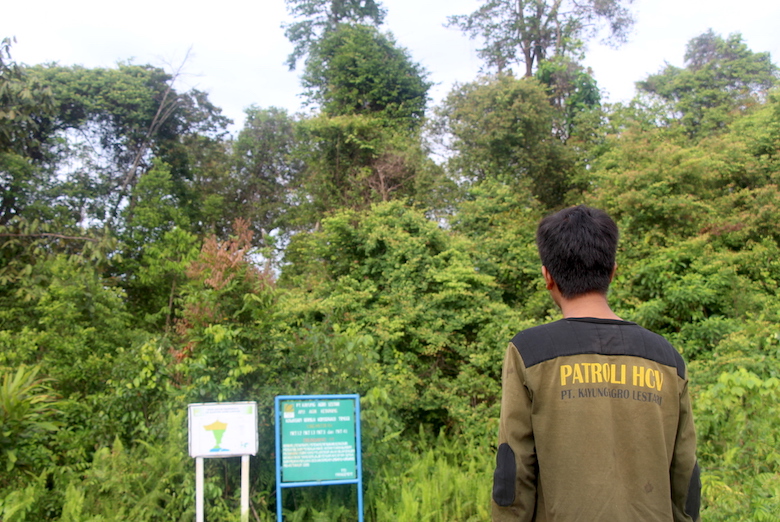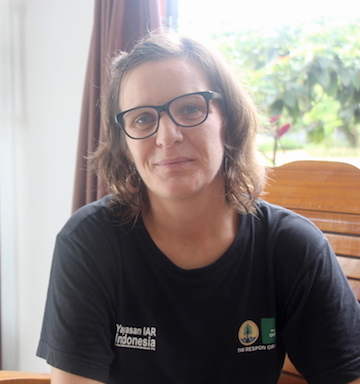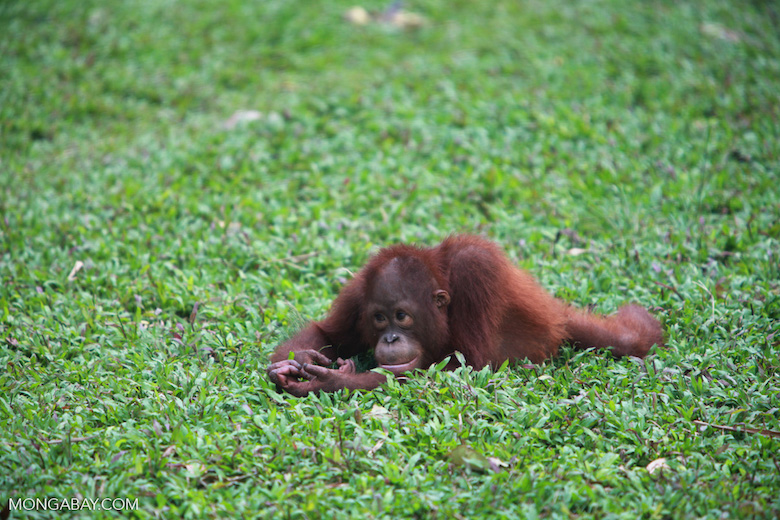- Rescuing orangutans from plantations and moving them to protected lands has long been the conservation approach in response to rapid deforestation and plantation development in Borneo.
- Increasingly, conservationists insist that commercial interests should share the burden of conserving orangutans by creating “high conservation value” forest enclaves on their properties.
- Industry, through the Roundtable on Sustainable Palm Oil, is starting to make progress on this issue. But some NGOs, grown impatient, have started working directly with companies to protect orangutans on oil-palm plantations in Borneo.
- Even there, however, progress remains slow.
On the library shelves of its Nyaru Menteng rehabilitation center in Central Kalimantan, Indonesia, the Borneo Orangutan Survival Foundation (BOSF) has row upon row of bound volumes, each bearing the picture of a rescued orangutan and its BOSF moniker: orphaned baby Kejora, rehabilitated Mona, injured Grepy, and over 1,100 more.
Each album contains an animal’s exhaustive life story: where it was found, its favorite foods, periodic ailments, and daily activities (painstakingly recorded in five-minute increments) for the first two months after BOSF reintroduced it into the wild — all the details a doting parent might note.
Rescuing orangutans from plantations and moving them to protected lands has long been the conservation approach in response to rapid deforestation and plantation development in Borneo. BOSF has played a lead role in these efforts. But now it, along with other orangutan conservation outfits, is trying to reduce the number of rescues and work with oil-palm companies to maintain orangutan habitat on plantations and keep these apes in their original homes.

Field manager Jhanson Regalino, who heads the NGO’s Central Kalimantan region activities, told Mongabay he wants no more orangutan “adoptions.” Instead let the apes remain on the oil-palm plantations that 80 percent of orangutans at BOSF’s Nyaru Menteng center come from, he said.
Regalino insists that commercial interests should share the burden of conserving orangutans by creating “high conservation value” (HCV) forest enclaves on their properties, rather than simply contracting BOSF — and other conservation groups like Orangutan Foundation International and International Animal Rescue (IAR) — to “translocate” stranded animals into protected forests elsewhere.
In fact, that’s what the companies are supposed to be doing anyway. Principle 5 of the charter of the Roundtable on Sustainable Palm Oil (RSPO), a group that many of the companies these NGOs work with belong to, concerns environmental responsibility. The clause states that all members must conduct biodiversity surveys ahead of any clearing or construction activity. If endangered species are found, the company is responsible for “ensuring” legal protection for the animals, “controlling” illegal hunting in the area, and “developing responsible measures to resolve human-wildlife conflicts.” The company must also identify and manage HCV habitat, and attempt to preserve any existing wildlife corridors.

But to date, NGOs have responded to many calls from oil palm companies to remove orangutans stranded on their properties. Critics say this violates the spirit — if not the letter — of their RSPO commitments. Currently, BOSF moves orangutans into protected areas in exchange for a fee of 35,000 rupiah ($2.60) per evicted animal per day that it transits through the group’s rehabilitation center. (“Food expenses,” explained Denny Kurniawan, the manager of BOSF’s Nyaru Menteng rehabilitation facility.)
The NGOs’ change of heart isn’t born out of callousness, but simple arithmetic. “Upkeep is expensive and it is hard to find places to release orangutans in,” Karmele Sanchez, director of IAR’s rehabilitation center in southwest Borneo, told Mongabay.

On the island of Borneo, where most of the world’s remaining 60,000 orangutans live, conversion of forest to oil-palm plantations is one of the major threats to orangutan survival. A recent analysis showed that about 25,000 square miles, or 9 percent of Borneo, had already been converted to oil-palm plantations by 2010. Today, a fifth of the Bornean orangutan’s range on the west side of the island lies in still-undeveloped oil palm concessions, according to the Arcus Foundation’s recently published report, State of the Apes.
If companies continue handing orangutans over to NGOs to move to protected forests there is a danger of overcrowding resident populations, Sanchez and others say.
Reform through RSPO
Industry, for its part, is starting to get the message. The RSPO, a voluntary association of around 2,800 oil-palm businesses and conservation outfits, formed in 2004 with the stated purpose of making oil-palm plantations “legal, economically viable, environmentally appropriate and socially beneficial.” Membership has come to be seen as a proxy for “sustainable” palm oil because companies seeking membership, and whose products bear the RSPO eco-label, need to comply with a list of criteria.
However, some environmental NGOs have grown impatient with how opaque and slow companies have been to implement conservation measures, particularly the HCV land assessment and resulting management processes. Now they are forming committees to speed up and “standardize” processes in the hope that their recommendations will be adopted by the RSPO.

For instance, two committees, both made up of oil-palm producers and conservation NGOs, recently formed to focus on environmental sustainability and orangutan conservation. One of them, the Palm Oil and NGO Alliance, or PONGO Alliance, formed in mid-2015, and is spearheaded by the UK-based NGO Orangutan Land Trust. (Pongo is the orangutan’s Latin genus name.) The group’s goal is to create a standard for company HCV land assessments and translate that into sustainable company policies. The 16-member group includes five plantation companies, two land assessors, and a number of conservation outfits.
The RSPO currently places too much emphasis on “‘outputs’ rather than ‘outcomes,’” explained Carl Traeholt, a PONGO Alliance member and the Southeast Asia program director for the Copenhagen Zoo. Traeholt likens the situation to an aid agency that counts the number of English classes they sponsored rather than the number of class attendees who can pass an English language proficiency test. Similarly, he told Mongabay, “documenting that there were two stakeholder meetings” before clearing land does not equate to free, prior, and informed consent from neighboring communities — even if it fulfills RSPO requirements.
As for managing orangutans within a plantation’s HCV land, Traeholt thinks a truly outcome-oriented approach would involve companies consistently gauging whether orangutans within their property have “sufficient food, water, nesting sites, and available mates.”

This would require a company “knowing, as far as possible, each individual orangutan in their estate forest.” A simple task, according to Traeholt, as long as an HCV plot has 20 or fewer orangutans. From his work helping survey concessions belonging to Malaysian oil-palm company United Plantations and Singaporean-owned Wilmar, Traeholt has a “hunch” that’s how many orangutans live in their HCV lots. But to date, he lamented, few oil-palm companies have done full population surveys of the orangutans on their properties.
NGOs and companies team up outside RSPO
Some orangutan conservationists are not just less optimistic that companies will ever be able to effectively manage orangutans on their properties than the RSPO committee participants are, but outright distrustful of RSPO coalition building.
Hardi Baktiantoro is the founder of the Centre for Orangutan Protection. He quit working for BOSF in 2007, after the NGO helped remove 256 orangutans from oil-palm plantations, including properties owned by RSPO members Musim Mas, Wilmar, and Bumitama.
“At first glance, the RSPO seems to perfectly address the environmental issues of oil palm and even orangutans,” said Baktiantoro in an email to Mongabay. “There are many criteria and principles that members must [adhere] to. The question is: why are these companies still clearing forests and orangutan still continuing to become victims?”
Baktiantoro sees the RSPO as “a means for companies to get a green name, which is important for their image among consumers.”
“But once they get the name, what follows,” he asked. “Commitment isn’t just about finishing ‘homework’ or changing your behavior once you’ve been called out. Commitment means not endangering orangutans.”

Field managers at RSPO and PONGO Alliance-affiliate NGOs BOSF and IAR concede that the newly hatched committees have been slow to create change. So the two non-profits are also trying another tactic: liaising directly with individual companies to design and monitor the companies’ HCV land and to implement “best management practices” with respect to orangutans.
The results so far are mixed.
IAR director Sanchez said that best management practices include companies creating standard operating procedures for how to deal with orangutans found on their properties; informing villagers living near company lands that they cannot hunt orangutans and need to comply with other environmental regulations on company grounds; and establishing “conservation teams” to “assist in the monitoring, rescue and translocation of orangutans within their concessions.”

For instance, as part of the new model, IAR is working with oil-palm producer PT Kayung Agro Lestari (PT KAL), a subsidiary of agriculture giant ANJ-Agri. The company has a conservation team that regularly monitors orangutans on its HCV forests. At the end of the devastating fires that swept across Kalimantan last year, IAR relocated 11 orangutans they found in PT KAL plantations back into company HCV forest.
These collaborative partnerships with companies are the only effective way to deal with orangutans whose habitat has been replaced by oil-palm plantations, according to IAR director Sanchez. Companies that ask for orangutans to be translocated off their properties are only “getting rid of problems,” she said. The landscape near IAR is filled with oil-palm concessions, and Sanchez sees “nowhere enough forest to put all rescued orangutans” without “overflowing” national parks and other protected areas.
BOSF’s Regalino thinks that another reason to work individually with oil palm companies is that a company’s designated HCV plot, unlike a forest managed in part by government agencies, NGOs, and villages, can be expressly dedicated to conservation and nurturing orangutans in situ.
“In Mawas, there are a lot of interests,” Regalino explained, referring to the legally protected area of 1,193 square miles in Central Kalimantan that BOSF co-manages with the regional government forestry office. The latest IUCN tally estimates that Mawas is home to 5,000 orangutans of the wurmbii subspecies, one of the larger groups of this subspecies worldwide. The Mawas forest borders oil-palm plantations, and illegal loggers, swallow-nest hunters, and a fleet of traditional river fishermen visit the area. So even though the forest is protected on paper, in reality it’s difficult to successfully conserve it or the orangutans living there.
Regalino said that ironically it is easier to define conditions for conservation lands on company properties. Since the company legally owns the land, there is only one formal stakeholder to negotiate with. Even so, the process is far from simple.
BOSF is creating a wildlife corridor on 15 square miles of HCV forest inside an oil-palm concession belonging to PT Mentaya Sawit Mas, a Central Kalimantan subsidiary of Wilmar, one of the world’s biggest palm-oil producers. BOSF, Wilmar, and the Central Kalimantan government signed a five-year memorandum of understanding for this project in 2011. At that time, Regalino thought a best-management-practices protocol would be drawn up within a couple of years.

But progress has been slow. It turns out that historical stakes within a land holding, not just legal tenants, also have to be dealt with. “You need everyone, particularly the villages within or near the oil palm concessions to ok the plan,” he said.
No easy task, he conceded. “One day they might agree,” he said. “Then the next day, they get suspicious of us.”
Last July, BOSF finally got all five villages within PT Mentaya Sawit Mas’s concession to sign another MOU to cooperate.
Conservationists agree that collaborating with companies and communities on conservation work is complex and, at times, frustratingly slow. Even so, IAR’s lead biologist Gail Campbell-Smith holds that it is the only course forward to avoid moving more and more orangutans into overcrowded protected areas — or giving up on the species altogether.
“Sure, PT KAL were responsible for a lot of orangutan deaths early on but there is no use dwelling on the past,” she told Mongabay at IAR’s rehabilitation center. “Companies have to be part of the answer now. Their concession lands are located in the middle of what protected land remains.”
| CLARIFICATION: A previous version of this story stated simply that BOSF moves orangutans into protected areas in exchange for a fee of 35,000 rupiah ($2.60) per evicted animal per day. This version clarifies that the fee is charged for days that the animal transits through the BOSF’s rehabilitation center. |
Citation
- Gaveau, D.L.A., Sloan, S., Molidena, E., Yaen, H., Sheil, D., Abram, N.K., et al. (2014). Four Decades of Forest Persistence, Clearance and Logging on Borneo. PLoS ONE 9(7): e101654.
